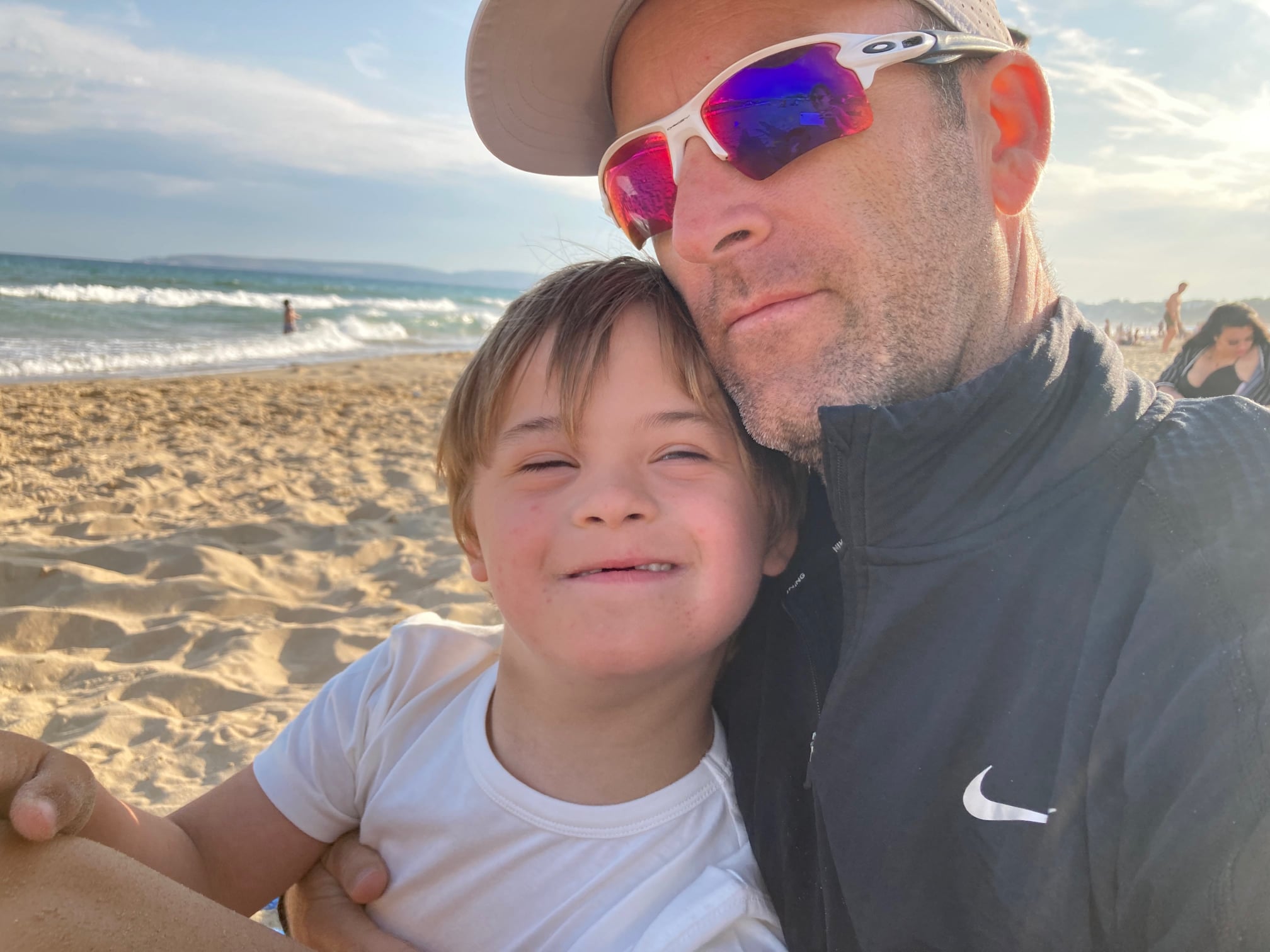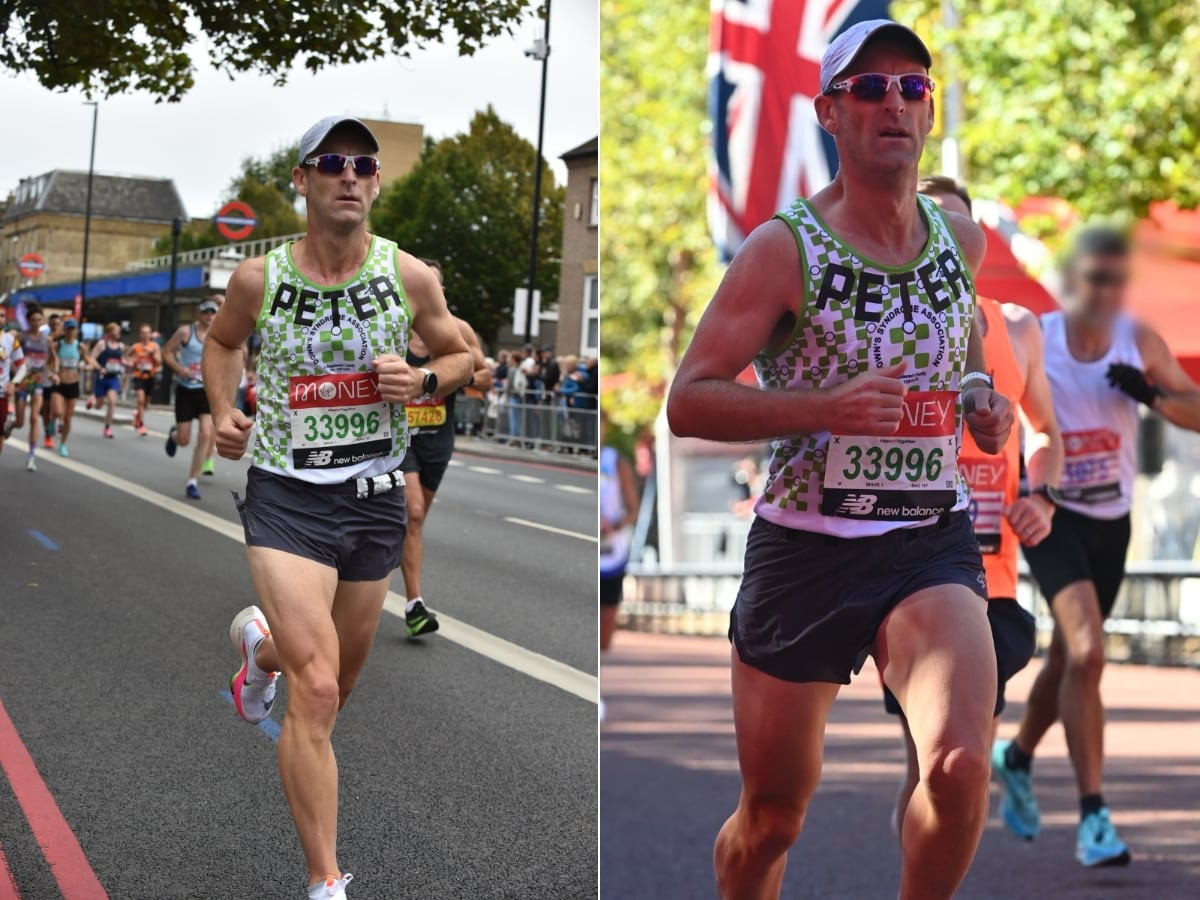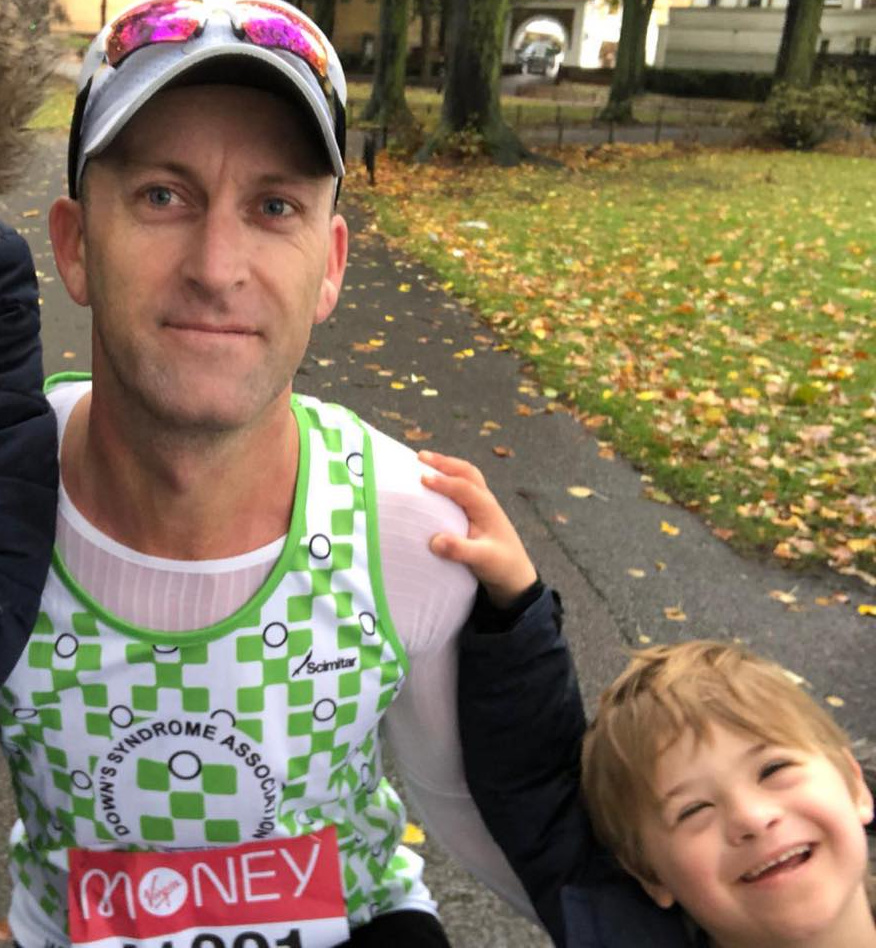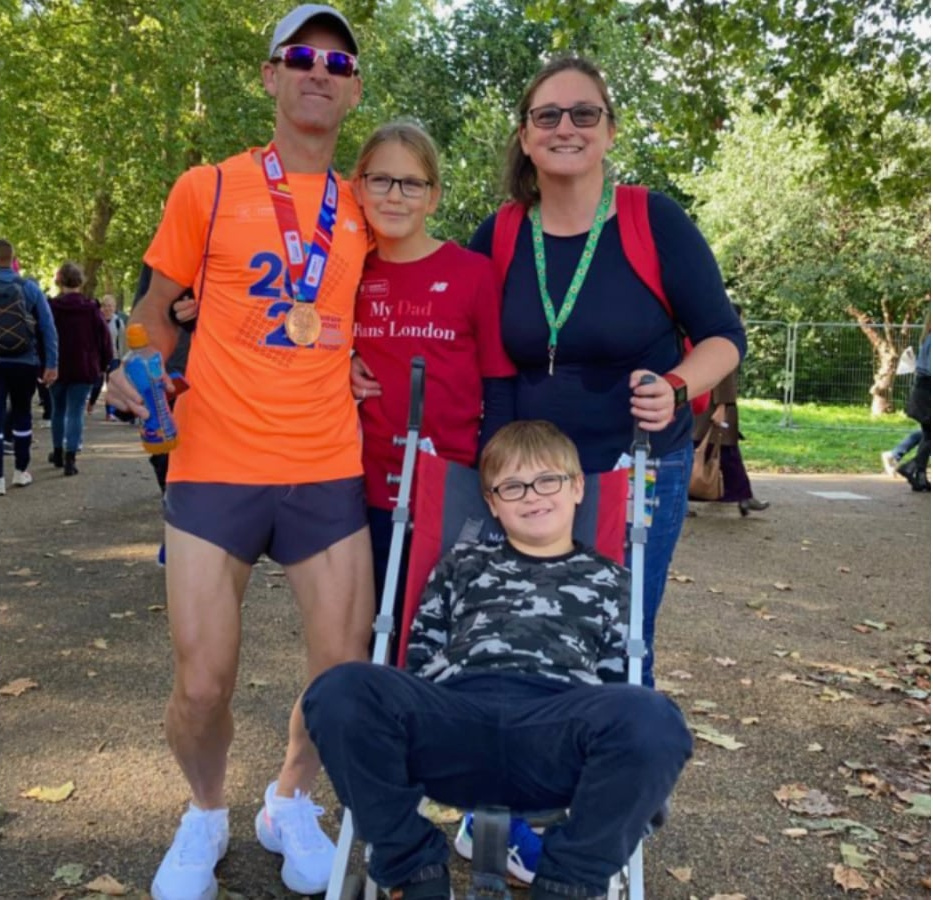Written by Peter Stafford
Pre-marathon – why I’m taking on the challenge
In 2013 my son, Santiago, was born and my life changed. Over these past eight years I’ve come to know my little man inside-out, but I’ve never really had a conversation with him. In fact, he’s never really had much of a conversation with anyone.
Santi has Down’s syndrome, and that makes it really hard for him to communicate, and to express himself. He can say quite a few things, stringing some words together in English and in Spanish, but most people wouldn’t necessarily understand what he’s trying to say.
 My work occasionally takes me to foreign countries where I don’t speak the language. In some places I can pick up a few bits and pieces, and have a general idea of what’s going on. In other places I’m saved by the brilliant locals who have made the Herculean effort to learn English. However, there are places where you just feel alienated and helpless due to your inability to interact with others and to accomplish the most rudimentary of tasks. For me this is always fleeting and I can always fall back on the comfort of knowing that once I’m home everything will be back to normal, and everything will be easy.
My work occasionally takes me to foreign countries where I don’t speak the language. In some places I can pick up a few bits and pieces, and have a general idea of what’s going on. In other places I’m saved by the brilliant locals who have made the Herculean effort to learn English. However, there are places where you just feel alienated and helpless due to your inability to interact with others and to accomplish the most rudimentary of tasks. For me this is always fleeting and I can always fall back on the comfort of knowing that once I’m home everything will be back to normal, and everything will be easy.
Well, for people like Santi, it’s never easy. It doesn’t matter if we’re abroad or at home with his closest friends – communication is always really hard for him.
Every Tuesday afternoon I pick Santi up from school and take him to the Down’s Syndrome Association (DSA) in Teddington where another excellent charity (21 & Co) run speech and language therapy sessions for kids like Santi. There he gets additional support that will help him to integrate into society as he develops. This is one of the many things that the DSA facilitates. Through the DSA we learnt of the ‘Tiger Cubs’ football program at QPR. I’ve been taking Santi to these football sessions since he was four, and it’s been a fantastic opportunity for him.
I’ve focussed upon communication here, but for people with Down’s syndrome, this is just one of the challenges that they have to deal with.
Even before Santi’s arrival, the DSA has been a constant source of support, providing guidance to us as parents, making assessments of Santi’s capabilities, helping us deal with the mountain of paperwork required to obtain educational support, advertising sporting opportunities, hosting events for the wider Down’s syndrome community, and many other things.
In return, my super-wife has helped by going out to hospitals and speaking to doctors and nurses about how they can better support parents whose little ones arrive with Down’s syndrome. Hopefully, through these sorts of efforts, parents in the future might be met with heart-felt congratulations for their new arrival rather than awkward commiserations followed by a rundown of all the health problems that they’ll probably have to deal with.
Now it’s my turn to give a little back. So, I’m going to run the London Marathon and I hope that in doing so, I can raise some money to help support the Down’s Syndrome Association. I can assure you that running the marathon is going to be really easy. I gather that the training and the race itself might hurt a little bit from time to time, and it’s going to be a bit of a challenge to balance training through the winter with work – but it’s all easy.
My son – the happiest guy I know, and someone who’s taught me significantly more than most others – conquers far greater challenges on a daily basis.
If my fundraising and physical efforts can help to increase awareness and acceptance of Down’s syndrome then it would all be worth it.
We all have our own challenges, but I hope that you might make a small donation to this worthy cause. The DSA does great work, and their efforts help to make the lives of people with Down’s syndrome a little bit easier.
You can still sponsor Peter here
 My Marathon Journey
My Marathon Journey
Well, I finally got to run the 2021 London Marathon in person!
Roughly two years ago I was notified by the Down’s Syndrome Association that I had a place to run for their charity in the 2020 London Marathon, scheduled for the traditional time of April 2020. I would have turned 42 a month later, and I liked the idea of running this 42km before turning 42.
Clearly things haven’t quite gone to plan over the past couple of years. The 2020 April event couldn’t take place with Covid-19 coming through, and it was postponed to October 2020. That event ended up being run as a virtual event, and I completed that, mostly in the dark, on a cold and rainy Sunday morning. It wasn’t easy running alone and with roads open to the normal traffic, but I managed to get it done and was hooked by the experience of testing myself over that distance.
Training
When I started training initially, it was hard to set a target time. As I trained, my fitness developed, and I began revising targets. Gradually, times that I thought to be impossible started to become tempting. Paces that seemed impossible to sustain started to become more comfortable, and I kept seeing the correlation between the amount and quality of work that I put in, and the results that I saw.
Running the ‘virtual’ London Marathon
Heading out last year on that cold and wet Sunday morning, I had the internal goal that I was going to try to break the three-hour barrier. I kept that fairly quiet, as it certainly wasn’t a given by any stretch of the imagination. I’d picked up a calf injury just a few weeks before, and wasn’t sure how realistic this was and if my body would allow me to push as hard as I’d need to. However, I gave myself a chance and managed to hold things together when it became tough towards the end. I finally finished in 2:58, running through a red ribbon held up by my kids, and was very, very happy.
More training!
I still had the chance to run in-person for the following year, and the London Marathon team decided reasonably early to hold the event on October 3, 2021. I was buzzing after the virtual marathon, so looked for other events that could keep me motivated with structured training. Travelling options were very limited, so I entered the Richmond Marathon (which is about as local as it could get), and started training for that. I moved to a new training program with a heavier load in terms of mileage and training intensity. It wasn’t easy, but really helped me through the lockdown period to get outside early in the morning (often in the dark and cold winter mornings).
As the Richmond Marathon approached, covid was still in full swing and the event ended up being cancelled. That was a real blow after the work I’d put in, but when the news came in, I’d recently picked up another calf injury and so at least decided not to rush back to training too quickly. However, shortly after the cancellation we received news that an alternative event could take place a few weeks later than planned on private land at the Kempton Park Race Course. This would be essentially eight laps of a 5km circuit, with various covid restrictions in place. After all the training I’d done, I wanted to test myself and so signed up.
The Kempton Park Marathon took place on May 29th, the day before my 43rd birthday. As the day approached, the weather became warmer and warmer such that actual race was run in pretty tough conditions. It was my first long-distance (in-person) race since a half-marathon I’d done (with extremely limited training) back in 2008. I knew I was pretty fit, and started out well — a bit quicker than planned. I was able to hold the pace well over the first 30km, but as the day warmed up, the legs grew heavier, and my hydration suffered. Over the last few kilometres I was really hanging on, and was very near collapse as I struggled home over the last km or so. I ended up losing multiple minutes over those final stages, but managed to stay on my feet.
 In the end I came home in 10th place overall (not a huge field), and 1st place in the 40+ category. My official time of 2:52 was still a huge PB, but more importantly a massive learning experience. That day I found a physical limit, and was very determined to redefine where that limit was for my next attempt…
In the end I came home in 10th place overall (not a huge field), and 1st place in the 40+ category. My official time of 2:52 was still a huge PB, but more importantly a massive learning experience. That day I found a physical limit, and was very determined to redefine where that limit was for my next attempt…
Because the Kempton Park Marathon was relatively late (compared to the original Richmond Marathon that was supposed to be in March), I now had less time to prepare for the big event in October. I tried to start a new program which was some mix of a 12 and 16 week program, but picked up the volume too quickly after the Kempton Park Marathon and suffered with some hamstring tendonitis.
I decided to back off, and restart properly with some more gradual build-up, and then a solid 12-week training block. This time I again decided to challenge my body and increased the training volume per week, and also moved to having no scheduled rest days (running at least once per day, with some double-days mainly for recovery).
The volume I was running wasn’t easy to maintain, and I’ve been through quite a few pairs of shoes in this journey. However, I monitored my nutrition in training very carefully with help from Supersapiens and their continuous glucose monitoring system, and tried to generally keep a close eye on my sleep/recovery and overall cardio and muscular demands. In the end, I managed to get through that 12-week block without any injuries, and did take days off from time to time (sometimes driven by the need to recover, sometimes driven by the general challenges that life throws up).
Ultimately I was able to front up on Sunday morning and to execute my plan. I had a very ambitious target to try to break 2:45. I thought that was very challenging, but achievable, if things went to plan – but I also had the residual doubts lingering from the way my body fell apart at the end of the last marathon. This time I wanted to be more conservative over the first 30km or so, and then see how much I could push over the final 12km.
Marathon day finally arrives
The weather turned out as good as I could have hoped after very troubling forecasts in the days leading up to the race. There was still a general wind coming in from the west – which means a headwind for a lot of the run, and for all of that final 12km. However, it wasn’t overly strong in the end and didn’t require major changes of pacing or approach.
I managed to finally finish with a time of 2:46, another big improvement of my personal best, and a time that I can feel proud about. In truth, I actually thought that I was on track to break my 2:45 target. However, I must’ve lost concentration and drifted slightly through some middle portions, and particularly through Canary Wharf where the GPS breaks up through the tall buildings and you can only pace by feel. I had felt that I’d gone out more quickly than planned and tried to manage that by restraining myself over the earlier kilometres. However, it turned out that I reined things in slightly more than I’d thought. This, combined with the slight loss of concentration through the middle, accounted for the essentially one second per km drop in pace that would have been needed to get that 2:45. When I realised all of this late in the race, it was then too late to recover that time. If I tried to recover that minute over the last few km I probably would have pushed to hard and potentially blown out.
 I simply decided to hold a strong pace, gradually ratchet it up as I approached the finish and kept a look out for Ana and the kids who I knew were going to be cheering me on near the end. I obviously wanted to try to still look broadly in control by the time they saw me (if Ana saw me near collapse she probably wouldn’t let me do another marathon!) They managed to get a spot quite near the end, just after 40km and around Big Ben. Finally seeing them was great. They had provided me with loads of motivation through my training, and I wanted to be able to celebrate the moment with them – even if only fleetingly. Passing them allowed me to briefly relax, and to then push strongly through to the finish. The last couple of km ended up with the fastest splits of the whole run. Charging towards Buckingham Palace passing the runners around you is a feeling that’s pretty hard to match.
I simply decided to hold a strong pace, gradually ratchet it up as I approached the finish and kept a look out for Ana and the kids who I knew were going to be cheering me on near the end. I obviously wanted to try to still look broadly in control by the time they saw me (if Ana saw me near collapse she probably wouldn’t let me do another marathon!) They managed to get a spot quite near the end, just after 40km and around Big Ben. Finally seeing them was great. They had provided me with loads of motivation through my training, and I wanted to be able to celebrate the moment with them – even if only fleetingly. Passing them allowed me to briefly relax, and to then push strongly through to the finish. The last couple of km ended up with the fastest splits of the whole run. Charging towards Buckingham Palace passing the runners around you is a feeling that’s pretty hard to match.
The Down’s Syndrome Association had provided us with large letters to show our names over our singlets. I was initially sceptical about emblazing my name over my chest, but it turned out being brilliant. All the way around the course I had strangers cheering out my name and shouting ‘Go Peter!’ It was simultaneously very odd and very motivating. Other runners were often looking around expecting to see some famous celebrity that all the crowed seemed to recognise. It meant that I ran around a lot of the course giving ‘thumbs up’ to strangers, but it was also like having a tailwind of human spirit for much of the course.
After all the months of covid restrictions, you could just feel the energy from the thousands of people lining the course who were able to get out in crowds and support others. The moto of the London Marathon organisers this was ‘we run together’, and on Sunday that expression seemed like more than just a tagline. It really was a special collective experience, and I’m very grateful for the Down’s Syndrome Association for allowing me to run for them.
You can still sponsor Peter here
A huge thank you to Peter and all our marathon runners – we love having you as part of #team21
